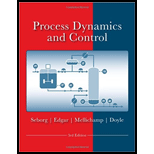
(a)
Interpretation:
The surge system that can handle the larger step disturbances in
Concept introduction:
For chemical processes, dynamic models consisting ordinary differential equations are derived through unsteady-state conservation laws. These laws generally include mass and energy balances.
The process models generally include algebraic relationships which commence from
For large value of time, the asymptotic value of
This theorem is applicable only if
(b)
Interpretation:
The system that provides best damping for a step disturbance in
Concept introduction:
For chemical processes, dynamic models consisting ordinary differential equations are derived through unsteady-state conservation laws. These laws generally include mass and energy balances.
The process models generally include algebraic relationships which commence from thermodynamics, transport phenomena, chemical kinetics, and physical properties of the processes.
An influence on or within an oscillatory system which results in the reduction, restriction, or prevention of its oscillations is termed as damping. There are three types of damping in a control system, namely, underdamped system, critically damped system, and overdamped system.
(c)
Interpretation:
The results in part (a) and part (b) are to be verified using computer simulation.
Concept introduction:
For chemical processes, dynamic models consisting ordinary differential equations are derived through unsteady-state conservation laws. These laws generally include mass and energy balances.
The process models generally include algebraic relationships which commence from thermodynamics, transport phenomena, chemical kinetics, and physical properties of the processes.
An influence on or within an oscillatory system which results in the reduction, restriction, or prevention of its oscillations is termed as damping. There are three types of damping in a control system, namely, underdamped system, critically damped system, and overdamped system.
Trending nowThis is a popular solution!

Chapter 5 Solutions
Process Dynamics and Control, 4e
 Introduction to Chemical Engineering Thermodynami...Chemical EngineeringISBN:9781259696527Author:J.M. Smith Termodinamica en ingenieria quimica, Hendrick C Van Ness, Michael Abbott, Mark SwihartPublisher:McGraw-Hill Education
Introduction to Chemical Engineering Thermodynami...Chemical EngineeringISBN:9781259696527Author:J.M. Smith Termodinamica en ingenieria quimica, Hendrick C Van Ness, Michael Abbott, Mark SwihartPublisher:McGraw-Hill Education Elementary Principles of Chemical Processes, Bind...Chemical EngineeringISBN:9781118431221Author:Richard M. Felder, Ronald W. Rousseau, Lisa G. BullardPublisher:WILEY
Elementary Principles of Chemical Processes, Bind...Chemical EngineeringISBN:9781118431221Author:Richard M. Felder, Ronald W. Rousseau, Lisa G. BullardPublisher:WILEY Elements of Chemical Reaction Engineering (5th Ed...Chemical EngineeringISBN:9780133887518Author:H. Scott FoglerPublisher:Prentice Hall
Elements of Chemical Reaction Engineering (5th Ed...Chemical EngineeringISBN:9780133887518Author:H. Scott FoglerPublisher:Prentice Hall
 Industrial Plastics: Theory and ApplicationsChemical EngineeringISBN:9781285061238Author:Lokensgard, ErikPublisher:Delmar Cengage Learning
Industrial Plastics: Theory and ApplicationsChemical EngineeringISBN:9781285061238Author:Lokensgard, ErikPublisher:Delmar Cengage Learning Unit Operations of Chemical EngineeringChemical EngineeringISBN:9780072848236Author:Warren McCabe, Julian C. Smith, Peter HarriottPublisher:McGraw-Hill Companies, The
Unit Operations of Chemical EngineeringChemical EngineeringISBN:9780072848236Author:Warren McCabe, Julian C. Smith, Peter HarriottPublisher:McGraw-Hill Companies, The





